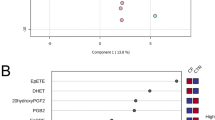Abstract
Background
To date, no evidence exists in the literature as to the effects of inhaled corticosteroids (ICs) on salivary composition in patients with bronchial asthma.
Objective
The aim of this study was to assess the effect of ICs on salival composition.
Methods
Adult patients attending an outpatient respiratory clinic who were classified into two groups (controls and patients with bronchial asthma receiving ICs), were recruited in this cross-sectional study. For each participant, data of clinical records, baseline history of asthma, and regular IC dose were recorded. A sample of stimulated saliva was collected and processed for investigation of mucin 5B (MUC5B), lipoxygenase (LPO), total antioxidant capacity, and 8-hydroxydeoxyguanosine (8-OHdG) levels.
Results
Overall, 103 patients (49 controls and 54 patients receiving regular treatment with ICs) were recruited. No differences in comorbidities or smoking habits were observed. Patients treated with high-doses of ICs showed lower levels of salival MUC5B compared with those treated with medium IC doses or those not treated with ICs (1.60 vs. 2.20 vs. 2.53 ng/mL; p = 0.042).
Conclusion
In patients with asthma, treatment with high-doses of ICs is associated with reduced levels of salivary MUC5B. This effect can explain some of the effects of ICs on oral health.


Similar content being viewed by others
References
Global Initiative for Asthma. Global Strategy for Asthma Management and Prevention. 2014. Available at: www.ginasthma.org. Accessed 12 May 2015.
Spanish guidelines for asthma management (GEMA). 2009. Available at: www.gemasma.com. Accessed 12 May 2015.
Olin JT, Wechsler ME. Asthma: pathogenesis and novel drugs for treatment. BMJ. 2014;349:g5517.
Chauhan BF, Ducharme FM. Anti-leukotriene agents compared to inhaled corticosteroids in the management of recurrent and/or chronic asthma in adults and children. Cochrane Database Syst Rev. 2012;(5):CD002314.
O’Byrne PM, Naya IP, Kallen A, Postma DS, Barnes PJ. Increasing doses of inhaled corticosteroids compared to adding long-acting inhaled beta2-agonists in achieving asthma control. Chest. 2008;134:1192.
Dubus JC, Marguet C, Deschildre A, et al. Local side-effects of inhaled corticosteroids in asthmatic children: influence of drug, dose, age, and device. Allergy. 2001;56:944–8.
Godara N, Godara R, Khullar M. Impact of inhalation therapy on oral health. Lung India. 2011;28:272–5.
Pramanik R, Osailan SM, Challacombe SJ, Urquhart D, Proctor GB. Protein and mucin retention on oral mucosal surfaces in dry mouth patients. Eur J Oral Sci. 2010;118:245–53.
Zalewska A, Zwierz K, Zółkowski K, Gindzieński A. Structure and biosynthesis of human salivary mucins. Acta Biochim Pol. 2000;47:1067–79.
Frenkel ES, Ribbeck K. Salivary mucins protect surfaces from colonization by cariogenic bacteria. Appl Environ Microbiol. 2015;81:332–8.
Kasai H. Analysis of a form of oxidative DNA damage, 8-hydroxy-2′-deoxyguanosine, as a marker of cellular oxidative stress during carcinogenesis. Mutat Res. 1997;387:147–63.
García-Río F, Calle M, Burgos F, et al. Spirometry. Spanish Society of Pulmonology and Thoracic Surgery (SEPAR). Arch Bronconeumol. 2013;49:388–401.
Dweik RA, Boggs PB, Erzurum SC, American Thoracic Society Committee on Interpretation of Exhaled Nitric Oxide Levels (FENO) for Clinical Applications, et al. An official ATS clinical practice guideline: interpretation of exhaled nitric oxide levels (FENO) for clinical applications. Am J Respir Crit Care Med. 2011;184:602–15.
Yagi K. Simple assay for the level of total lipid peroxides in serum or plasma. Methods Mol Biol. 1998;108:101–6.
Tabak LA, Levine MJ, Mandel ID, Ellison SA. Role of salivary mucins in the protection of the oral cavity. J Oral Pathol. 1982;11:1–17.
Dijkema T, Terhaard CH, Roesink JM, et al. MUC5B levels in submandibular gland saliva of patients treated with radiotherapy for head-and-neck cancer: a pilot study. Radiat Oncol. 2012;7:91.
Caffery B, Heynen ML, Joyce E, Jones L, Ritter R, Senchyna M. MUC1 expression in Sjogren’s syndrome, KCS, and control subjects. Mol Vis. 2010;16:1720–7.
Alcázar-Navarrete B, Gómez-Moreno G, Aguilar-Salvatierra A, Guardia J, José Romero Palacios P. Xerostomia relates to the degree of asthma control. J Oral Pathol Med. 2015;44:273–7.
Gómez-Moreno G, Aguilar-Salvatierra A, Guardia J, et al. The efficacy of a topical sialogogue spray containing 1 % malic acid in patients with antidepressant-induced dry mouth: a double-blind, randomized clinical trial. Depress Anxiety. 2013;30:137–42.
Gómez-Moreno G, Guardia J, Aguilar-Salvatierra A, et al. Effectiveness of malic acid 1% in patients with xerostomia induced by antihypertensive drugs. Med Oral Patol Oral Cir Bucal. 2013;18:e49–55.
Acknowledgments
The authors would like to thank Mrs. Huda Khaldy from the Immunoanalysis and Radiobiochemistry Unit, University of Granada, who made the determination of salivary compounds possible.
Author information
Authors and Affiliations
Corresponding author
Ethics declarations
Funding
This study was funded by Fundación Respira 255|2012 and FIS Project PI10/00932 of the Spanish Ministry of Science and Innovation, Health Institute Carlos III, in the hallmark of Research Group CTS-654 ‘Investigación Farmacológica en Odontología’ from Junta de Andalucía (Spain).
Conflict of interest
Bernardino Alcázar Navarrete reports receiving personal fees from Novartis AG, Boehringer-Ingelheim, GlaxoSmithKline, Almirall, and Astra-Zeneca, as well as grants and personal fees from Menarini, outside the submitted work. Pedro José Romero Palacios, Antonio Aguilar-Salvatierra, Javier Guardia, and Gerardo Gómez-Moreno have no conflicts of interest to disclose.
Ethical approval
This study was performed in accordance with the Declaration of Helsinki 1964 and its amendments. The study protocol, patient information and informed consent form were reviewed and approved by the responsible Ethics Committee of the Faculty of Medicine and Dentistry, University of Granada, Granada, Spain.
Informed consent
Informed consent was obtained from all individual participants in this study.
Rights and permissions
About this article
Cite this article
Navarrete, B.A., Palacios, P.J.R., Aguilar-Salvatierra, A. et al. Effect of Inhaled Corticosteroids on Salival Composition: A Cross-Sectional Study in Patients with Bronchial Asthma. Clin Drug Investig 35, 569–574 (2015). https://doi.org/10.1007/s40261-015-0313-7
Published:
Issue Date:
DOI: https://doi.org/10.1007/s40261-015-0313-7




